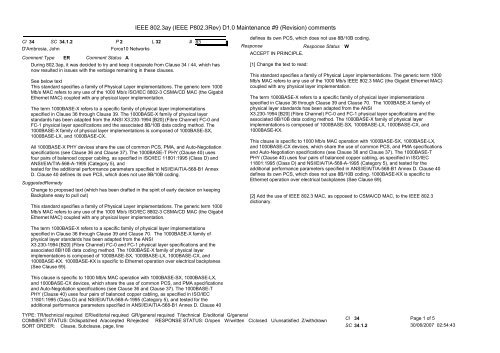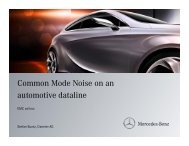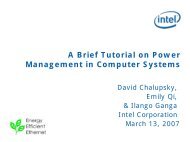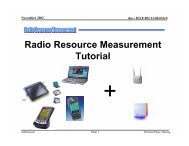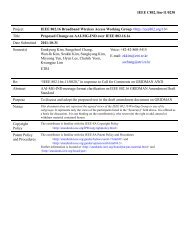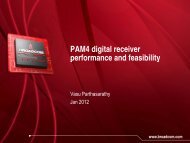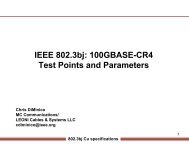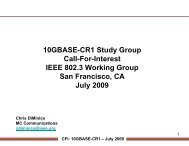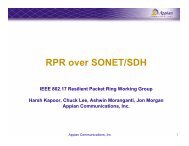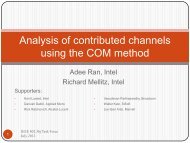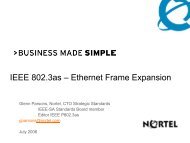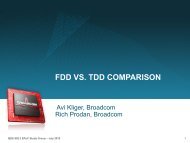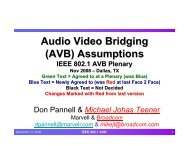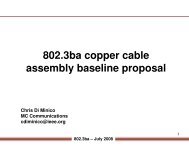IEEE 802.3ay (IEEE P802.3Rev) D1.0 Maintenance #9 (Revision ...
IEEE 802.3ay (IEEE P802.3Rev) D1.0 Maintenance #9 (Revision ...
IEEE 802.3ay (IEEE P802.3Rev) D1.0 Maintenance #9 (Revision ...
Create successful ePaper yourself
Turn your PDF publications into a flip-book with our unique Google optimized e-Paper software.
Cl 34 SC 34.1.2 P 2 L 32<br />
D'Ambrosia, John Force10 Networks<br />
<strong>IEEE</strong> <strong>802.3ay</strong> (<strong>IEEE</strong> <strong>P802.3Rev</strong>) <strong>D1.0</strong> <strong>Maintenance</strong> <strong>#9</strong> (<strong>Revision</strong>) comments<br />
# 83<br />
Comment Type ER Comment Status A<br />
During 802.3ap, it was decided to try and keep it separate from Clause 34 / 44, which has<br />
now resulted in issues with the verbiage remaining in these clauses.<br />
See below text<br />
This standard specifies a family of Physical Layer implementations. The generic term 1000<br />
Mb/s MAC refers to any use of the 1000 Mb/s ISO/IEC 8802-3 CSMA/CD MAC (the Gigabit<br />
Ethernet MAC) coupled with any physical layer implementation.<br />
The term 1000BASE-X refers to a specific family of physical layer implementations<br />
specified in Clause 36 through Clause 39. The 1000BASE-X family of physical layer<br />
standards has been adapted from the ANSI X3.230-1994 [B20] (Fibre Channel) FC-0 and<br />
FC-1 physical layer specifications and the associated 8B/10B data coding method. The<br />
1000BASE-X family of physical layer implementations is composed of 1000BASE-SX,<br />
1000BASE-LX, and 1000BASE-CX.<br />
All 1000BASE-X PHY devices share the use of common PCS, PMA, and Auto-Negotiation<br />
specifications (see Clause 36 and Clause 37). The 1000BASE-T PHY (Clause 40) uses<br />
four pairs of balanced copper cabling, as specified in ISO/IEC 11801:1995 (Class D) and<br />
ANSI/EIA/TIA-568-A-1995 (Category 5), and<br />
tested for the additional performance parameters specified in NSI/EIA/TIA-568-B1 Annex<br />
D. Clause 40 defines its own PCS, which does not use 8B/10B coding.<br />
SuggestedRemedy<br />
Change to proposed text (which has been drafted in the spirit of early decision on keeping<br />
Backplane easy to pull out)<br />
This standard specifies a family of Physical Layer implementations. The generic term 1000<br />
Mb/s MAC refers to any use of the 1000 Mb/s ISO/IEC 8802-3 CSMA/CD MAC (the Gigabit<br />
Ethernet MAC) coupled with any physical layer implementation.<br />
The term 1000BASE-X refers to a specific family of physical layer implementations<br />
specified in Clause 36 through Clause 39 and Clause 70. The 1000BASE-X family of<br />
physical layer standards has been adapted from the ANSI<br />
X3.230-1994 [B20] (Fibre Channel) FC-0 and FC-1 physical layer specifications and the<br />
associated 8B/10B data coding method. The 1000BASE-X family of physical layer<br />
implementations is composed of 1000BASE-SX, 1000BASE-LX, 1000BASE-CX, and<br />
1000BASE-KX. 1000BASE-KX is specific to Ethernet operation over electrical backplanes<br />
(See Clause 69).<br />
This clause is specific to 1000 Mb/s MAC operation with 1000BASE-SX, 1000BASE-LX,<br />
and 1000BASE-CX devices, which share the use of common PCS, and PMA specifications<br />
and Auto-Negotiation specifications (see Clause 36 and Clause 37). The 1000BASE-T<br />
PHY (Clause 40) uses four pairs of balanced copper cabling, as specified in ISO/IEC<br />
11801:1995 (Class D) and NSI/EIA/TIA-568-A-1995 (Category 5), and tested for the<br />
additional performance parameters specified in ANSI/EIA/TIA-568-B1 Annex D. Clause 40<br />
defines its own PCS, which does not use 8B/10B coding.<br />
Response<br />
ACCEPT IN PRINCIPLE.<br />
[1] Change the text to read:<br />
Response Status W<br />
TYPE: TR/technical required ER/editorial required GR/general required T/technical E/editorial G/general<br />
COMMENT STATUS: D/dispatched A/accepted R/rejected RESPONSE STATUS: O/open W/written C/closed U/unsatisfied Z/withdrawn<br />
SORT ORDER: Clause, Subclause, page, line<br />
This standard specifies a family of Physical Layer implementations. The generic term 1000<br />
Mb/s MAC refers to any use of the 1000 Mb/s <strong>IEEE</strong> 802.3 MAC (the Gigabit Ethernet MAC)<br />
coupled with any physical layer implementation.<br />
The term 1000BASE-X refers to a specific family of physical layer implementations<br />
specified in Clause 36 through Clause 39 and Clause 70. The 1000BASE-X family of<br />
physical layer standards has been adapted from the ANSI<br />
X3.230-1994 [B20] (Fibre Channel) FC-0 and FC-1 physical layer specifications and the<br />
associated 8B/10B data coding method. The 1000BASE-X family of physical layer<br />
implementations is composed of 1000BASE-SX, 1000BASE-LX, 1000BASE-CX, and<br />
1000BASE-KX.<br />
This clause is specific to 1000 Mb/s MAC operation with 1000BASE-SX, 1000BASE-LX,<br />
and 1000BASE-CX devices, which share the use of common PCS, and PMA specifications<br />
and Auto-Negotiation specifications (see Clause 36 and Clause 37). The 1000BASE-T<br />
PHY (Clause 40) uses four pairs of balanced copper cabling, as specified in ISO/IEC<br />
11801:1995 (Class D) and NSI/EIA/TIA-568-A-1995 (Category 5), and tested for the<br />
additional performance parameters specified in ANSI/EIA/TIA-568-B1 Annex D. Clause 40<br />
defines its own PCS, which does not use 8B/10B coding. 1000BASE-KX is specific to<br />
Ethernet operation over electrical backplanes (See Clause 69).<br />
[2] Add the use of <strong>IEEE</strong> 802.3 MAC, as opposed to CSMA/CD MAC, to the <strong>IEEE</strong> 802.3<br />
dictionary.<br />
Cl 34<br />
SC 34.1.2<br />
Page 1 of 5<br />
30/06/2007 02:54:43
Cl 34 SC 34.1.4 P 3 L 18<br />
D'Ambrosia, John Force10 Networks<br />
<strong>IEEE</strong> <strong>802.3ay</strong> (<strong>IEEE</strong> <strong>P802.3Rev</strong>) <strong>D1.0</strong> <strong>Maintenance</strong> <strong>#9</strong> (<strong>Revision</strong>) comments<br />
# 84<br />
Comment Type ER Comment Status A<br />
Handling of merging of 802.3ap has left some inconsistencies in Clause 34 / 44.<br />
See verbiage below -<br />
34.1.4 Auto-Negotiation, type 1000BASE-X<br />
Auto-Negotiation (Clause 37) provides a 1000BASE-X device with the capability to detect<br />
the abilities (modes of operation) supported by the device at the other end of a link<br />
segment, determine common abilities, and configure for joint operation. Auto-Negotiation is<br />
performed upon link startup through the use of a special sequence of reserved link<br />
codewords. Clause 37 adopts the basic architecture and algorithms from Clause 28, but<br />
not the use of fast link pulses.<br />
SuggestedRemedy<br />
Add sentence at end -<br />
Auto-Negotiation for 1000BASE-KX is defined in Clause 73.<br />
Response<br />
ACCEPT IN PRINCIPLE.<br />
Response Status W<br />
Will add the sentence 'Backplane Auto-Negotiation defined in Clause 73 applies to<br />
1000BASE-KX.'.<br />
Cl 36 SC 36.1.1 P 33 L 9<br />
D'Ambrosia, John Force10 Networks<br />
Comment Type ER Comment Status A<br />
Related to merger of 802.3ap into document has created issues -<br />
# 85<br />
This clause specifies the Physical Coding Sublayer (PCS) and the Physical Medium<br />
Attachment (PMA) sublayer that are common to a family of 1000 Mb/s Physical Layer<br />
implementations, collectively known as 1000BASE-X. There are currently three<br />
embodiments within this family: 1000BASE-CX, 1000BASE-LX,<br />
and 1000BASE-SX. The 1000BASE-CX embodiment specifies operation over a single<br />
copper media: two pairs of 150 ┘ balanced copper cabling. 1000BASE-LX specifies<br />
operation over a pair of optical fibers using long-wavelength optical transmission.<br />
1000BASE-SX specifies operation over a pair of optical fibers<br />
using short-wavelength optical transmission. The term 1000BASE-X is used when referring<br />
to issues common to any of the subvariants.<br />
While it is assumed that this was done to keep 802.3ap stand-alone, Clause 70 states that<br />
Clause 36 is required, therefore Clause 36 needs to be modified to handle these<br />
references.<br />
SuggestedRemedy<br />
Replace with<br />
This clause specifies the Physical Coding Sublayer (PCS) and the Physical Medium<br />
Attachment (PMA) sublayer that are common to a family of 1000 Mb/s Physical Layer<br />
implementations, collectively known as 1000BASE-X. There are currently four<br />
embodiments within this family: 1000BASE-CX, 1000BASE-KX, 1000BASE-LX, and<br />
1000BASE-SX. The 1000BASE-CX embodiment specifies operation over a single copper<br />
media: two pairs of 150 ┘ balanced copper cabling. The 1000BASE-CX embodiment<br />
specifies operation over an electrical backplane. 1000BASE-LX specifies operation over a<br />
pair of optical fibers using long-wavelength optical transmission. 1000BASE-SX specifies<br />
operation over a pair of optical fibers using short-wavelength optical transmission. The term<br />
1000BASE-X is used when referring to issues common to any of the subvariants.<br />
Response<br />
ACCEPT IN PRINCIPLE.<br />
Response Status W<br />
TYPE: TR/technical required ER/editorial required GR/general required T/technical E/editorial G/general<br />
COMMENT STATUS: D/dispatched A/accepted R/rejected RESPONSE STATUS: O/open W/written C/closed U/unsatisfied Z/withdrawn<br />
SORT ORDER: Clause, Subclause, page, line<br />
Will add 1000BASE-KX to list as suggested and will also change 'The 1000BASE-CX<br />
embodiment specifies operation over a single copper media: two pairs of 150 ..' to read<br />
'The 1000BASE-CX embodiment specifies operation over two pairs of 150 ..'<br />
Cl 36<br />
SC 36.1.1<br />
Page 2 of 5<br />
30/06/2007 02:54:43
Cl 36 SC 36.2.4.13 P 47 L 35<br />
Thaler, Pat Broadcom<br />
<strong>IEEE</strong> <strong>802.3ay</strong> (<strong>IEEE</strong> <strong>P802.3Rev</strong>) <strong>D1.0</strong> <strong>Maintenance</strong> <strong>#9</strong> (<strong>Revision</strong>) comments<br />
# 106<br />
Comment Type TR Comment Status R<br />
Treatment of alignment of the start delimiter is inconsistant between 1 Gb/s and 10 Gb/s<br />
Ethernet. In 1 Gb/s, the alignment is done by allowing an octet of preamble to be dropped if<br />
it overlaps the end of an /I/ and overwritting the next octet with /S/. In 10 Gb/s the full<br />
preamble is preserved by delaying the start of the preamble by up to 3 octets when<br />
necessary for alignment.<br />
Allowing an option for a 1 Gb/s PHY to behave in a manner similar to a 10 Gb/s PHY will<br />
cause no problems. It produces at most 1 octet of IPG shrinkage but IPG shrinkage can<br />
occur from clock compensation and must be tolerated.<br />
SuggestedRemedy<br />
Add, "Alternatively, when TX_EN is asserted during transmission of an ordered_set, the<br />
PCS may delay the packet to align the first octet of preamble to after the ordered_set and<br />
replace that octet with SPD."<br />
Response<br />
REJECT.<br />
The state diagram, which takes precedence over this text, requires that /T/ be sent when<br />
TX_EN is de-asserted. If a FIFO were added in front of the TX state machine the last byte<br />
of the CRC would be over written by the /T/. To insert the proposed text without introducing<br />
ambiguity would require changes to the state diagram.<br />
---000---<br />
First motion<br />
Proposed REJECT.<br />
Proposed response text. The state machine specifies operation the other way and the state<br />
machine would have precedence over this text.<br />
Y: 4 N: 2 A: 8<br />
Response Status W<br />
Cl 37 SC 37.1.1 P 81 L 8<br />
D'Ambrosia, John Force10 Networks<br />
Comment Type ER Comment Status A<br />
Merger of 802.3ap has created issues with existing text -<br />
# 86<br />
Clause 37 describes the 1000BASE-X Auto-Negotiation (AN) function that allows a device<br />
(local device) to advertise modes of operation it possesses to a device at the remote end of<br />
a link segment (link partner) and to detect corresponding operational modes that the link<br />
partner may be advertising.<br />
Furhtermore, it is noted in Clause 73 - "It is recommended that a device that has<br />
negotiated 1000BASE-KX operation through this clause not perform<br />
Clause 37 Auto-Negotiation." (Clause 73.1 Page 453, L36), which would seem to suggest<br />
to not point to Clause 37 AN for 1000BASE-KX, which also does not specify Clause 37 as<br />
optional in Table 70-1.<br />
SuggestedRemedy<br />
change to<br />
Clause 37 describes the Auto-Negotiation (AN) function for 1000BASE-LX, 1000BASE-SX,<br />
and 1000BASE-CX that allows a device (local device) to advertise modes of operation it<br />
possesses to a device at the remote end of a link segment (link partner) and to detect<br />
corresponding operational modes that the link partner may be advertising. Use of<br />
"1000BASE-X" in this clause refers to 1000BASE-LX, 1000BASE-SX, and 1000BASE-CX<br />
physical sublayers.<br />
Response<br />
ACCEPT IN PRINCIPLE.<br />
Response Status W<br />
TYPE: TR/technical required ER/editorial required GR/general required T/technical E/editorial G/general<br />
COMMENT STATUS: D/dispatched A/accepted R/rejected RESPONSE STATUS: O/open W/written C/closed U/unsatisfied Z/withdrawn<br />
SORT ORDER: Clause, Subclause, page, line<br />
Clause 37 is optionally allowed for 1000BASE-KX. Instead will add the text 'Backplane<br />
Auto-Negotiation defined in Clause 73 applies to 1000BASE-KX.'.<br />
Cl 37<br />
SC 37.1.1<br />
Page 3 of 5<br />
30/06/2007 02:54:43
Cl 48 SC 48.1 P 229 L 7<br />
D'Ambrosia, John Force10 Networks<br />
Comment Type ER Comment Status A<br />
Integration of 802.3ap into document has resulted in issues -<br />
<strong>IEEE</strong> <strong>802.3ay</strong> (<strong>IEEE</strong> <strong>P802.3Rev</strong>) <strong>D1.0</strong> <strong>Maintenance</strong> <strong>#9</strong> (<strong>Revision</strong>) comments<br />
# 88<br />
This clause specifies the Physical Coding Sublayer (PCS) and the Physical Medium<br />
Attachment (PMA) sublayer that are common to a family of 10 Gb/s Physical Layer<br />
implementations, collectively known as 10GBASE-X. The 10GBASE-LX4 PMD described in<br />
Clause 53 and 10GBASE-CX4 PMD described in<br />
Clause 54 are members of the 10GBASE-X PHY family.<br />
SuggestedRemedy<br />
change to<br />
This clause specifies the Physical Coding Sublayer (PCS) and the Physical Medium<br />
Attachment (PMA) sublayer that are common to a family of 10 Gb/s Physical Layer<br />
implementations, collectively known as 10GBASE-X. The 10GBASE-X PHY family consists<br />
of 10GBASE-CX4 (See Clause 54), 10GBASE-KX4 (See Clause 71), and 10GBASE-LX4<br />
(see Clause 53).<br />
Response<br />
ACCEPT.<br />
Response Status W<br />
Cl 48 SC 48.1.3.3 P 231 L 26<br />
D'Ambrosia, John Force10 Networks<br />
Comment Type ER<br />
Integration of 802.3ap<br />
# 89<br />
10GBASE-X supports the PMD sublayer and MDI specified in Clause 53 and Clause 54.<br />
The 10GBASE-LX4 and 10GBASE-CX4 PMDs perform the following functions:<br />
SuggestedRemedy<br />
change to<br />
10GBASE-X supports the PMD sublayer and MDI specified in Clause 53, Clause 54, and<br />
Clause 71. The 10GBASE-CX4, 10GBASE-KX4, and 10GBASE-LX4 perform the following<br />
functions:<br />
Response<br />
ACCEPT.<br />
Comment Status A<br />
Response Status W<br />
Cl 48 SC 48.2.4.2.3 P 240 L 2<br />
Brad, Booth AMCC<br />
# 49<br />
Comment Type TR Comment Status A<br />
There is a double "shall". The first shall applies to the list, and the second applies to the<br />
item d. Item d shall needs to be removed.<br />
SuggestedRemedy<br />
Change:<br />
... shall not be deleted.<br />
to be:<br />
... are not deleted.<br />
Response<br />
ACCEPT.<br />
Response Status W<br />
Cl 48 SC 48.7.4.x P 260 L 1<br />
D'Ambrosia, John Force10 Networks<br />
Comment Type ER Comment Status R<br />
Table at top looks to be for AN function, but no clause title.<br />
SuggestedRemedy<br />
add clause title above top table and re-order as appropriate<br />
Response<br />
REJECT.<br />
Response Status W<br />
TYPE: TR/technical required ER/editorial required GR/general required T/technical E/editorial G/general<br />
COMMENT STATUS: D/dispatched A/accepted R/rejected RESPONSE STATUS: O/open W/written C/closed U/unsatisfied Z/withdrawn<br />
SORT ORDER: Clause, Subclause, page, line<br />
# 93<br />
This table spans a page break - the title is at the start of the table on the previous page.<br />
Cl 48<br />
SC 48.7.4.x<br />
Page 4 of 5<br />
30/06/2007 02:54:43
Cl 70 SC 70.3 P 383 L 37<br />
Dawe, Piers Avago Technologies<br />
<strong>IEEE</strong> <strong>802.3ay</strong> (<strong>IEEE</strong> <strong>P802.3Rev</strong>) <strong>D1.0</strong> <strong>Maintenance</strong> <strong>#9</strong> (<strong>Revision</strong>) comments<br />
# 132<br />
Comment Type TR Comment Status A<br />
The PMD clause is trying to impose a 'shall' on a PCS. That is outside of its power. Also<br />
this violates layering because the PCS is not directly connected to the PMD, it's connected<br />
to the AN sublayer (see Fig, 73-1; the old Clause 37 AN is different, it is presented as part<br />
of the PCS). In principle, this clause could contain an informative NOTE that reminds the<br />
reader of a requirement on something else, made by another clause (or document). But I<br />
can't see any point in this case. The main issue is the wish to enforce Clause 73 AN with<br />
this PMD, which is addressed in 70.1.<br />
SuggestedRemedy<br />
Delete subclause 70.3 and associated PICS 70.10.4. Similarly delete 72.3, 72.10.4.1,<br />
71.3, 71.10.4.1.<br />
Response<br />
ACCEPT IN PRINCIPLE.<br />
Response Status W<br />
[1] Change 70.3 to read 'The PCS associated with this PMD is required to support the AN<br />
service interface primitive AN_LINK.indication as defined in 73.9. (See 36.2.5.2.7.).'<br />
[2] Remove subclause 70.10.4.1 (PICS).<br />
Cl 72 SC 72.3 P 399 L 45<br />
Dawe, Piers Avago Technologies<br />
# 137<br />
Comment Type TR Comment Status R<br />
This sentence 'In order to form a complete PHY, a PMD shall be combined with the<br />
appropriate sublayers' attempts to impose a condition on a complete PHY - but this clause<br />
is responsible for the PMD alone. The PMD is the lowest sublayer, not responsible for<br />
anything above it. Also there is no requirement to combine, merely to connect. If it is<br />
thought necessary to define what makes up a complete PHY of any name, then it must be<br />
done somewhere else e.g. using Table 69-1<br />
SuggestedRemedy<br />
Change to ''When {forming|part of} a complete PHY, a PMD is connected to the<br />
appropriate sublayers'. Same change for 71.1, 72.1. 53.1.<br />
Response<br />
REJECT.<br />
This was discussed during the balloting of <strong>IEEE</strong> P802.3ap and this was the consensus of<br />
the <strong>IEEE</strong> P802.3ap Task Force.<br />
M: Thaler<br />
S: Grow<br />
Y: 6 N: 1 A: 0<br />
Response Status W<br />
TYPE: TR/technical required ER/editorial required GR/general required T/technical E/editorial G/general<br />
COMMENT STATUS: D/dispatched A/accepted R/rejected RESPONSE STATUS: O/open W/written C/closed U/unsatisfied Z/withdrawn<br />
SORT ORDER: Clause, Subclause, page, line<br />
Cl 72<br />
SC 72.3<br />
Page 5 of 5<br />
30/06/2007 02:54:43


